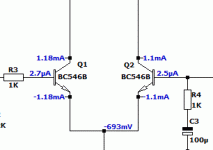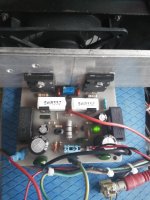Standing waves.Couldn't find the cause..
You're not using the original layout.
follow the layout by superR
P3A Comparison table ( long .... )
I had it posted earlier, but no one paid any heed. its a very good layout.
I have it working as my main stereo as well as a sub amp for HT. working since 2 years.
P3A Comparison table ( long .... )
I had it posted earlier, but no one paid any heed. its a very good layout.
I have it working as my main stereo as well as a sub amp for HT. working since 2 years.
I have TinaTI so I can't use your LT Spice file. Can you see how much current goes through each of BC546 input transistors?
Screenshot attached. In addition, each transistor is dissipating about 40mW with 35V rails.
Attachments
Hi Sakis @ East Electronics. I'm afraid any thread that says P3a somewhere in the title becomes a magnet for newbies and anyone else who wants to buy or make their own cheap PCB because ESP asks for serious money in total and they want to do what every other reply has done - DIY.
As for forum rules, etiquette or replying to the OP? They have no clue how forums are structured, no respect and don't read older threads which are about DIY where most aspects have all been done before and posted in other DIY threads - usually many times over.
As for forum rules, etiquette or replying to the OP? They have no clue how forums are structured, no respect and don't read older threads which are about DIY where most aspects have all been done before and posted in other DIY threads - usually many times over.
a magnet for newbies and anyone else who wants to buy or make their own cheap PCB because ESP asks for serious money in total and they want to do what every other reply has done - DIY.
It's not about money! It's about pleasure to do all by yourself..
With the help of the hobbyists and community...
As for reading; I can say for myself, I read every bit of line that I could find and try to understand best I can.
If I violate any of the forum rules, sorry about that.
No, the comments aren't directed at you, starbender and there's nothing unusual or wrong with your wish to DIY everything - it's what we would all like to do when we have the skills and facilities for it. Many newbies though, don't have much cash to buy anything so it is essential for them to make PCBs or use other construction methods.
The problem here is threadjacking. The fault is with the guys who derailed the thread with DIY discussion earlier, so now the thread is completely off-topic. The opening post (OP) of the thread states that the topic is about making a table of listening comparisons - please read it. It means listening comparisons with commercial products and this was his interest. What happened instead was that readers saw "P3a" and it was active so they figured it would be a place to also discuss their DIY plans or anything else about that ESP project. Others then followed this same lead and now it is threadjacked - useless as the reference I think Sakis intended.
Instead, replies could have been posted as a new thread or maybe continuing a not-too-old one that can easily be found with Google etc. and matched the DIY topic they actually wanted to discuss. There are many other P3a threads here that would be on-topic but this thread now has a meaningless title.
The problem here is threadjacking. The fault is with the guys who derailed the thread with DIY discussion earlier, so now the thread is completely off-topic. The opening post (OP) of the thread states that the topic is about making a table of listening comparisons - please read it. It means listening comparisons with commercial products and this was his interest. What happened instead was that readers saw "P3a" and it was active so they figured it would be a place to also discuss their DIY plans or anything else about that ESP project. Others then followed this same lead and now it is threadjacked - useless as the reference I think Sakis intended.
Instead, replies could have been posted as a new thread or maybe continuing a not-too-old one that can easily be found with Google etc. and matched the DIY topic they actually wanted to discuss. There are many other P3a threads here that would be on-topic but this thread now has a meaningless title.
Hello desert,
Sorry but it's really a bad design.
Grounding needs lot of improvement.
Regards
Prasi
Prasi can you show me how to layout or create a proper grounding in my layout?Hello desert,
Sorry but it's really a bad design.
Grounding needs lot of improvement.
Regards
Prasi
Ok. My P3A is working flawlessly.
Feeding 28vdc from C-core transformer&CRC power supply , 70mA bias, bd139-140 drivers, a1492&c3856 outputs.
I don't have scope, so I have no idea about technical perfection (or non perfection) of my work.
Dc offset is around 1-5mv for both channels.
Miller cap is 100pf ceramic.
I listened for five hours with nos pcm56 dac feeding p88 preamp and then p3a. Load is 4 ohm bookshelf speakers.
Sound is surprisingly well, balanced and dynamic. Not harsh.
I can say, it's quite close to my f5 but with higher gain.
It has more punch at low frequencies than my AM-69.
Overall, I think it has a lot of potential.
Btw, I used everything from my stash, so no ordered or special or butique parts..
Feeding 28vdc from C-core transformer&CRC power supply , 70mA bias, bd139-140 drivers, a1492&c3856 outputs.
I don't have scope, so I have no idea about technical perfection (or non perfection) of my work.
Dc offset is around 1-5mv for both channels.
Miller cap is 100pf ceramic.
I listened for five hours with nos pcm56 dac feeding p88 preamp and then p3a. Load is 4 ohm bookshelf speakers.
Sound is surprisingly well, balanced and dynamic. Not harsh.
I can say, it's quite close to my f5 but with higher gain.
It has more punch at low frequencies than my AM-69.
Overall, I think it has a lot of potential.
Btw, I used everything from my stash, so no ordered or special or butique parts..
Use the best quality Miller compensation cap you can find. Ceramic dielectric types may generally be OK but not the common Y5 or X7R grade stuff as it can affect the sound adversely. NPO or COG types are good but finding an adequate voltage rating type is not normally easy. Modern ceramic caps are usually MLCC type which use COG type ceramic and are just fine. You have quite low supply voltages which may be safe at modest power levels with a common 50V rated Y5 ceramic cap, if that is all you can obtain.
Caps should be rated for at least the total supply voltage, i.e from +rail to -rail which would normally be 70 or 86V, meaning a 100V capacitor rating is required. A polypropylene film or polystyrene film type cap. would be excellent but not a common polyester film type.
X7R, X5R, C0G…: A Concise Guide to Ceramic Capacitor Types
Caps should be rated for at least the total supply voltage, i.e from +rail to -rail which would normally be 70 or 86V, meaning a 100V capacitor rating is required. A polypropylene film or polystyrene film type cap. would be excellent but not a common polyester film type.
X7R, X5R, C0G…: A Concise Guide to Ceramic Capacitor Types
Last edited:
Anyone tried Sanken a1492&c3856 outputs, with bd139&140 drivers?
Is it ok to use these outputs for p3a?
Also, I think I used large heatsinks, because with 75mA bias heatsinks never gets warm at all. Dc offset looks like stable at between 1-5mvdc.
Yes in general is a very fine combination
- Home
- Amplifiers
- Solid State
- P3A Comparison table ( long .... )

